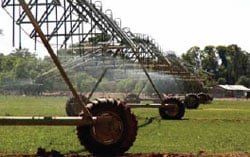Centre Pivot and Lateral Move (CPLM) irrigation systems have many advantages over surface irrigation systems. However careful consideration regarding system design, as well as adequate system maintenance and management, is essential to achieving these benefits. The following points need to be considered when installing CPLM systems:
Advantages and disadvantages of CPLM systems
Advantages:
Precise application – Systems will apply a prescribed volume of water to match crop water requirements. This reduces the opportunity for surface runoff or deep percolation if the system is designed to match soil infiltration characteristics.
Reduced variability – Reported application efficiencies for well designed CPLM systems are generally in the 80-95% range, compared to 50-90% for surface irrigation systems.
Lower labour requirements – Generally lower than surface irrigation but depends on the system and\or the degree of automation of the machine.
Opportunities for fertigation – Allows the targeted application of small quantities of nutrients, with a reasonable uniformity of application. It may also be used to apply herbicides and pesticides.
Less landforming – The system can work on rolling topography. However, there may be a requirement for some landforming for surface drainage or rainfall induced runoff.
Disadvantages:
Cost – Systems have a relatively high capital cost compared to surface irrigation systems. The running costs can also be significant and need to be evaluated during the design process.
Energy requirements – These systems require some form of energy source (electric or diesel) to operate.
Water quality – Water may need to be filtered before use to prevent system blockages with sediments. Poor water quality can affect longevity of irrigation infrastructure.
Skill requirement – Operation and maintenance of these systems will require different skills to those required for surface irrigation systems.

Centre Pivot systems
Centre Pivots (CP) are usually less than 500 m long, covering an area of up to 80 ha. They are anchored at one end, rotating around a fixed central point and require water and a power source delivered to the centre tower.
Labour requirements are a little bit less than lateral move systems, and significantly less than surface irrigation. Irrigation scheduling is easiest with full circle Centre Pivot’s because the driest ground is always in front of the machine.
A Centre Pivot will cover 78% of a square, however corners of paddocks can now be irrigated with ‘swing arm’ systems. These allow more land to be covered however can increase the cost and complexity of the system.
The outer spans of a Centre Pivot move the fastest and cover a larger area compared to the inner spans. As a result, water application rate increases towards the outside of the machine. The larger the Centre Pivot, the higher the application rate at the outside. With larger machines (>300 m), low infiltration into the soil and runoff can become significant problems that can affect your production.
Lateral Move systems
Lateral Move systems share similar technology to pivots and will be more suited to large rectangular areas. Lateral Move systems are not anchored and both ends of the machine move at a constant speed up and down a paddock.
A guidance system is essential to keeping the system on-track. Lateral Move systems are commonly 800-1000 m long, covering an area up to 200 ha. Water is supplied either to the middle (centre-feed) or at one end (end-feed) of the machine.
Water supply can be from an open channel, with a lift pump and power plant mounted on a cart-tower assembly, or alternatively from a flexible hose connected to a water hydrant. Increased labour requirements over CP systems can be due to maintaining the channel and guidance system or changing the supply hydrant.
Scheduling is more difficult because once the machine reaches the end of the paddock it is now at the wettest end and can either irrigate the wettest ground first next irrigation, or travel back dry to the other end of the paddock. This can cause wheel tracking problems and reduces usable time.
Investing in CPLM systems
Before you can make a decision on investing in CPLM systems, you need to know what you want to achieve with this investment.
Some of the aspects you need to consider are:
- Are you converting to a CPLM system from a border-check system or from a green field site? This could have different implications with regards to costs and what you want to achieve by your investment.
- Is water saving your main goal for considering a CPLM system? In sandy soils you generally have substantial water savings, but not on heavy soil types.
- Is labour saving your main goal?
- There are substantial running costs associated with CPLM systems which you need to consider.
- Are you prepared to change your management to cater for the CPLM systems?
See the next article in the CPLM series – coming soon.

